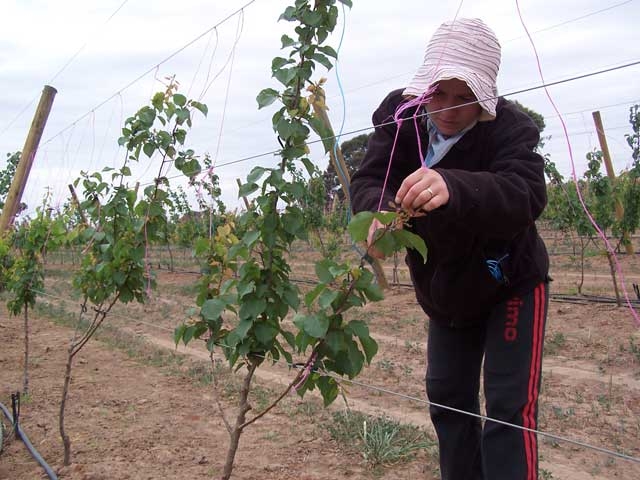The production of fruit is tied to management which affects how the tree’s resources (e.g. photosynthates, water, nutrients and hormones) are distributed throughout the tree.
- Facts about roots and root growth (continued from last month)
Soil compaction which decreases aeration when soil is wet and physically impedes root penetration, limits root growth. - Roots, especially feeding roots, are sensitive to high soil temperatures. Roots grow best in the range of 20C to 25C. Above 25C, root growth slows.
Tree roots do not grow when temperatures rise above the lethal 35C in the top 70 mm of soil wherever the surface receives direct radiation during summer.
This means that with long hot summers, root growth of fruit trees is decreased, especially in the upper depths of soil where most of the feeder roots grow. - Mulching increases root growth in the soil surface because soil water content and soil temperature are kept ideal for root growth. Together with the shade that the canopies cast upon the soil surface, the soil temperature under the mulch can be kept between 22C and 25C.
- Roots grow mostly during the night.
- The root system cannot spread beyond the available soil volume when the roots are restricted.
Root restriction can result when fruit trees are planted in ridges over heavy clay (which restricts downward penetration) or planted closely in a high-density planting.
In high-density plantings the weight, length, volume and surface area of roots of individual fruit trees decreases in comparison to similar fruit trees planted at wider within-row distances. - Root restriction is a successful method to manipulate root growth because root restriction can dramatically increase precocity and yield efficiency of fruit trees.
Root restriction can also decrease canopy volume and growth control can increase linearly with decreasing soil volume. - Root growth is greatly affected by the general nutritional status of the tree. The effect is most likely indirect and acts through influencing the above-ground part of the tree first.
- Interference with the proper functioning of leaves, or with the transport of materials from the leaves, decreases root development of fruit crops.
- When root growth slows as fruit trees age, there will be less need to control tree vigour. The unused portion of photosynthates is channelled into fruit growth. This phenomenon causes higher yields to be obtained from mature fruit trees and probably also accounts for the high yields obtained from young fruit trees when grown on size-controlling rootstocks.
Climate and soils of the Goulburn Valley
The fruit-growing area in the Goulburn Valley (GV) consists of some 12,000 ha of irrigated orchards of stone and pome fruits.
The GV is also the centre of pear production in Australia.
Climate
The climate is semi-arid (Mediterranean type) characterised by cool wet winters and hot dry summers.
Rainfall
Rainfall is sparse (about 440 mm annually). Most rainfall is in winter and spring, with November being the wettest (average about 50 mm).
The irrigation season usually extends to seven months (mid-October to Mid-May), with an average of 280 mm of rain.
Soils
Many orchard soils are fragile and need careful management to sustain the production of fruit for a long time.
The red duplex soils which are commercially used for irrigated fruit trees in the GV are mainly shallow loams (0–150 mm) overlying heavy red-brown clays.
The surface soils (A horizons) have high silt contents and contain up to 80% fine sand plus clay, and less than 2% organic carbon, making them prone to ‘slaking’.
Slaking and clay dispersion
Slaking is the breakdown in water of soil aggregates (crumbs) to smaller aggregates. It is a quick process which occurs mainly within the first few minutes of wetting.
The other is ‘dispersion’ which is the breakdown in water of aggregates to individual sand, silt and clay particles. This is a slower process than slaking, often taking hours to complete.
Clay dispersion is particularly undesirable for fruit trees. It is the main cause of several problems in clay loam and clay soils, including low water intake, poor drainage, low aeration, surface crusting and cloddiness.
Clay dispersion at the surface typically results in hardsetting or crusting surface soil.
Subsoils (continued next month)
See this article in Tree Fruit Oct 2017






















